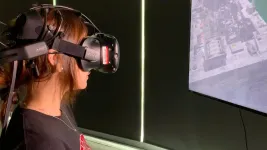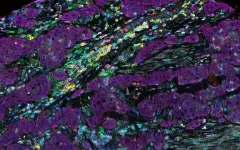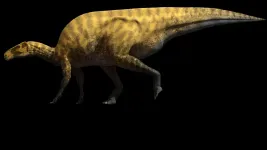University of Maryland researchers record brainwaves to measure 'cybersickness'
In a first-of-its-kind study, the UMD team used electroencephalography (EEG) to better understand and work toward solutions for VR-induced discomfort
2021-07-07
(Press-News.org) If a virtual world has ever left you feeling nauseous or disorientated, you're familiar with cybersickness, and you're hardly alone. The intensity of virtual reality (VR)--whether that's standing on the edge of a waterfall in Yosemite or engaging in tank combat with your friends--creates a stomach-churning challenge for 30-80% of users.
In a first-of-its kind study, researchers at the University of Maryland recorded VR users' brain activity using electroencephalography (EEG) to better understand and work toward solutions to prevent cybersickness. The research was conducted by Eric Krokos, who received his Ph.D. in computer science in 2018, and Amitabh Varshney, a professor of computer science and dean of UMD's College of Computer, Mathematical, and Natural Sciences.
Their study, "Quantifying VR cybersickness using EEG," was recently published in the journal Virtual Reality.
The term cybersickness derives from motion sickness, but instead of physical movement, it's the perception of movement in a virtual environment that triggers physical symptoms such as nausea and disorientation. While there are several theories about why it occurs, the lack of a systematic, quantified way of studying cybersickness has hampered progress that could help make VR accessible to a broader population.
Krokos and Varshney are among the first to use EEG--which records brain activity through sensors on the scalp--to measure and quantify cybersickness for VR users. They were able to establish a correlation between the recorded brain activity and self-reported symptoms of their participants. The work provides a new benchmark--helping cognitive psychologists, game developers and physicians as they seek to learn more about cybersickness and how to alleviate it.
"Establishing a strong correlation between cybersickness and EEG-measured brain activity is the first step toward interactively characterizing and mitigating cybersickness, and improving the VR experience for all," Varshney said.
EEG headsets have been widely used to measure motion sickness, yet prior research on cybersickness has relied on users to accurately recall their symptoms through questionnaires filled out after users have removed their headsets and left the immersive environment.
The UMD researchers said that such methods provide only qualitative data, making it difficult to assess in real time which movements or attributes of the virtual environment are affecting users.
Another complication is that not all people suffer from the same physical symptoms when experiencing cybersickness, and cybersickness may not be the only cause of these symptoms.
Without the existence of a reliable tool to measure and interactively quantify cybersickness, understanding and mitigating it remains a challenge, said Varshney, a leading researcher in immersive technologies and co-director of the Maryland Blended Reality Center.
For the UMD study, participants were fitted with both a VR headset and an EEG recording device, then experienced a minute-long virtual fly-through of a futuristic spaceport. The simulation included quick drops and gyrating turns designed to evoke a moderate degree of cybersickness.
Participants also self-reported their level of discomfort in real time with a joystick. This helped the researchers identify which segments of the fly-through intensified users' symptoms.
INFORMATION:
Written by Maria Herd
"Quantifying VR Cybersickness using EEG," was published in May 2021 in the academic journal Springer Virtual Reality.
This work was supported by the National Science Foundation (Grant Nos. 14-29404 and 15-64212), the state of Maryland's MPower Initiative and the NVIDIA CUDA Center of Excellence program. The content of this article does not necessarily reflect the views of these organizations.
[Attachments] See images for this press release:

ELSE PRESS RELEASES FROM THIS DATE:
2021-07-07
Although wastewater disposal has been the primary driving force behind increased earthquake activity in southern Kansas since 2013, a new study concludes that the disposal has not significantly changed the orientation of stress in the Earth's crust in the region.
Activities like wastewater disposal can alter pore pressure, shape and size within rock layers, in ways that cause nearby faults to fail during an earthquake. These effects are thought to be behind most recent induced earthquakes in the central and eastern United States.
It is possible, however, that human activity could also lead to earthquakes by altering the orientation of stresses that act on faults in the region, said U.S. Geological Survey seismologist ...
2021-07-07
As more evidence emerges that opioid overdose deaths have increased dramatically since the onset of COVID-19, the Centre for Addiction and Mental Health (CAMH), in collaboration with subject matter experts and medical regulatory authorities across Canada, have now released updated national clinical guidelines for the treatment of opioid use disorder. END ...
2021-07-07
When someone is suspected of criminal activity, one of the most important questions they are asked is if they have a credible alibi. Playing back past events in our minds, however, is not like playing back a video recording. Recollections of locations, dates, and companions can become muddled with the passage of time. If a suspect's memories are out of line with documented events, a once-plausible alibi can crumble and may be seen as evidence of guilt.
To put people's memories of past whereabouts to the test, a team of researchers tracked the locations of 51 volunteers for one month and found that their recollections were wrong approximately 36% of the time.
"This is the first study to examine memory for where ...
2021-07-07
Uppsala University scientists have designed a new mouse model that facilitates study of factors contributing to the progression of human bladder cancer and of immune-system activation when the tumour is growing. Using this model, they have been able to study how proteins change before, while and after a tumour develops in the bladder wall. The study has now been published in the scientific journal PLOS ONE.
"The model was designed both to contain specific oncogenes, as they're called -- mutations that can drive tumour growth -- and to show a high incidence of harmful mutations, which we often see in people who get bladder cancer. These harmful mutations arise because of smoking, for instance, which is ...
2021-07-07
Sudanese Islamic burial sites are distributed according to large-scale environmental factors and small-scale social factors, creating a galaxy-like distribution pattern, according to a study published July 7, 2021 in the open-access journal PLOS ONE by Stefano Costanzo of the University of Naples "L'Orientale" in Italy and colleagues.
The Kassala region of eastern Sudan is home to a vast array of funerary monuments, from the Islamic tombs of modern Beja people to ancient burial mounds thousands of years old. Archaeologists don't expect these monuments are randomly placed; their ...
2021-07-07
GPS data from cell phones may provide insight into how city inhabitants are using their urban greenspaces, in a study published July 7, 2021 in the open-access journal PLOS ONE by Meghann Mears and Paul Brindley from the University of Sheffield, UK, and colleagues.
Urban greenspaces confer a range of health and well-being benefits on city inhabitants and provide connection to nature. In this study, Mears and colleagues use cellphone GPS data to assess how frequently residents of the city of Sheffield in the UK engage with their local urban greenspaces, and whether this engagement was different across demographic groups.
The authors used the "Shmapped" app, developed as part of the Improving Well-being through Urban Nature project, to track how frequently 240 users based in Sheffield ...
2021-07-07
New iguanodon-like dinosaur identified from jawbone fossil from Spain was likely a 6-8m long herbivore, closely related to species found in modern-day China and Niger.
INFORMATION:
Article Title: A new Styracosternan hadrosauroid (Dinosauria: Ornithischia) from the Early Cretaceous of Portell, Spain
Funding: The authors received no specific funding for this work.
Competing Interests: The authors have declared that no competing interests exist.
Article URL: https://journals.plos.org/plosone/article?id=10.1371/journal.pone.0253599
...
2021-07-07
Brain microstructure may help explain the benefits of physical activity on cognition in older adults, according to MRI scans of 318 brains post-mortem.
INFORMATION:
Article Title: Physical activity, brain tissue microstructure, and cognition in older adults
Funding: This work was supported in part by the National Institute on Aging (https://www.nia.nih.gov) grants K25 AG61254 (RJD), K01 AG64044 (VNP), K01 AG50823 (BDJ), R01 AG17917 (DAB), R01 AG47976 (ASB), R01 AG56352 (ASB), R01 AG64233 (JAS, KA), and P30 AG10161 (DAB), the National Institute of Neurological Disorders and Stroke (https://www.ninds.nih.gov) grant UH3 NS100599 ...
2021-07-07
HOUSTON - (July 7, 2021) - A thin shell of soft polymer can help keep knotty ceramic structures from shattering, according to materials scientists at Rice University.
Ceramics made with 3D printers crack under stress like any plate or bowl. But covered in a soft polymer cured under ultraviolet light, the same materials stand a far better chance of keeping their structural integrity, much like a car windshield's treated glass is less likely to shatter.
The research at Rice's Brown School of Engineering, which appears in Science Advances, demonstrates the concept on schwarzites, complex lattices that for decades existed only as theory but can now be made with 3D printers. With added polymers, they come to resemble structures ...
2021-07-07
Microscopists have long sought to find a way to produce high-quality, deep-tissue imaging of living subjects in a timely fashion. Until now, they had to choose between image quality or speed when it comes to looking into the inner workings of complex biological systems.
Such a development would have a powerful impact on researchers in biology and in neuroscience, experts say. Now Dushan N. Wadduwage, a John Harvard Distinguished Science Fellow in Imaging at the FAS Center of Advanced Imaging, along with a team from MIT, detailed a new technique that would make that possible in a report in Science Advances.
In the paper, the team presents a new process that uses computational imaging to get high resolution images at a rate 100 to 1,000 times faster than other state-of-the-art ...
LAST 30 PRESS RELEASES:
[Press-News.org] University of Maryland researchers record brainwaves to measure 'cybersickness'
In a first-of-its-kind study, the UMD team used electroencephalography (EEG) to better understand and work toward solutions for VR-induced discomfort





